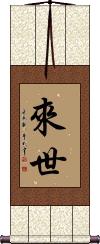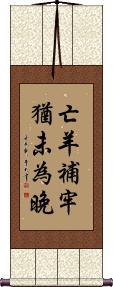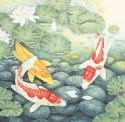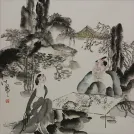Many custom options...
And formats...

Not what you want?
Try other similar-meaning words, fewer words, or just one word.
Feel free to email me with your request. If it's easy, I'll translate it for free and add it to this database of calligraphy for you.
Next Time in Chinese / Japanese...
Buy a Next Time calligraphy wall scroll here!
Personalize your custom “Next Time” project by clicking the button next to your favorite “Next Time” title below...
Eternal Life / Future Life
來世 is a word that can be used in many different ways.
It is often used to express the next life (life in heaven or wherever your soul is bound for). So it does have a religious overtone. However, it can also be used to express your life in the future - perhaps during your present lifetime.
It can also be translated as “the next world,” “the next generation,” “the time that is to come,” “otherworld,” or simply “posterity.”
See Also: Eternity | Rebirth | Reincarnation | Immortality
Better Late Than Never
It's Never Too Late Too Mend
Long ago in what is now China, there were many kingdoms throughout the land. This time period is known as “The Warring States Period” by historians because these kingdoms often did not get along with each other.
Sometime around 279 B.C. the Kingdom of Chu was a large but not particularly powerful kingdom. Part of the reason it lacked power was the fact that the King was surrounded by “yes men” who told him only what he wanted to hear. Many of the King's court officials were corrupt and incompetent which did not help the situation.
The King was not blameless himself, as he started spending much of his time being entertained by his many concubines.
One of the King's ministers, Zhuang Xin, saw problems on the horizon for the Kingdom, and warned the King, “Your Majesty, you are surrounded by people who tell you what you want to hear. They tell you things to make you happy and cause you to ignore important state affairs. If this is allowed to continue, the Kingdom of Chu will surely perish, and fall into ruins.”
This enraged the King who scolded Zhuang Xin for insulting the country and accused him of trying to create resentment among the people. Zhuang Xin explained, “I dare not curse the Kingdom of Chu but I feel that we face great danger in the future because of the current situation.” The King was simply not impressed with Zhuang Xin's words.
Seeing the King's displeasure with him and the King's fondness for his court of corrupt officials, Zhuang Xin asked permission from the King that he may take leave of the Kingdom of Chu, and travel to the State of Zhao to live. The King agreed, and Zhuang Xin left the Kingdom of Chu, perhaps forever.
Five months later, troops from the neighboring Kingdom of Qin invaded Chu, taking a huge tract of land. The King of Chu went into exile, and it appeared that soon, the Kingdom of Chu would no longer exist.
The King of Chu remembered the words of Zhuang Xin and sent some of his men to find him. Immediately, Zhuang Xin returned to meet the King. The first question asked by the King was “What can I do now?”
Zhuang Xin told the King this story:
A shepherd woke one morning to find a sheep missing. Looking at the pen saw a hole in the fence where a wolf had come through to steal one of his sheep. His friends told him that he had best fix the hole at once. But the Shepherd thought since the sheep is already gone, there is no use fixing the hole.
The next morning, another sheep was missing. And the Shepherd realized that he must mend the fence at once. Zhuang Xin then went on to make suggestions about what could be done to reclaim the land lost to the Kingdom of Qin, and reclaim the former glory and integrity of the Kingdom of Chu.
The Chinese idiom shown above came from this reply from Zhuang Xin to the King of Chu almost 2,300 years ago.
It translates roughly into English as...
“Even if you have lost some sheep, it's never too late to mend the fence.”
This proverb, 亡羊补牢犹未为晚, is often used in modern China when suggesting in a hopeful way that someone change their ways, or fix something in their life. It might be used to suggest fixing a marriage, quitting smoking, or getting back on track after taking an unfortunate path in life among other things one might fix in their life.
I suppose in the same way that we might say, “Today is the first day of the rest of your life” in our western cultures to suggest that you can always start anew.
Note: This does have Korean pronunciation but is not a well-known proverb in Korean (only Koreans familiar with ancient Chinese history would know it). Best if your audience is Chinese.
This in-stock artwork might be what you are looking for, and ships right away...
Gallery Price: $60.00
Your Price: $39.88
Gallery Price: $61.00
Your Price: $33.88
Gallery Price: $60.00
Your Price: $36.88
Gallery Price: $178.00
Your Price: $98.88
Not the results for next time that you were looking for?
Below are some entries from our dictionary that may match your next time search...
| Characters If shown, 2nd row is Simp. Chinese |
Pronunciation Romanization |
Simple Dictionary Definition |
佛 see styles |
fú fu2 fu hotoke ほとけ |
More info & calligraphy: Buddhism / Buddha(surname) Hotoke Buddha, from budh to "be aware of", "conceive", "observe", "wake"; also 佛陀; 浮圖; 浮陀; 浮頭; 浮塔; 勃陀; 勃馱; 沒馱; 母馱; 母陀; 部陀; 休屠. Buddha means "completely conscious, enlightened", and came to mean the enlightener. he Chinese translation is 覺 to perceive, aware, awake; and 智 gnosis, knowledge. There is an Eternal Buddha, see e.g. the Lotus Sutra, cap. 16, and multitudes of Buddhas, but the personality of a Supreme Buddha, an Ādi-Buddha, is not defined. Buddha is in and through all things, and some schools are definitely Pan-Buddhist in the pantheistic sense. In the triratna 三寳 commonly known as 三寳佛, while Śākyamuni Buddha is the first "person" of the Trinity, his Law the second, and the Order the third, all three by some are accounted as manifestations of the All-Buddha. As Śākyamuni, the title indicates him as the last of the line of Buddhas who have appeared in this world, Maitreya is to be the next. As such he is the one who has achieved enlightenment, having discovered the essential evil of existence (some say mundane existence, others all existence), and the way of deliverance from the constant round of reincarnations; this way is through the moral life into nirvana, by means of self-abnegation, the monastic life, and meditation. By this method a Buddha, or enlightened one, himself obtains Supreme Enlightenment, or Omniscience, and according to Māhāyanism leads all beings into the same enlightenment. He sees things not as they seem in their phenomenal but in their noumenal aspects, as they really are. The term is also applied to those who understand the chain of causality (twelve nidānas) and have attained enlightenment surpassing that of the arhat. Four types of the Buddha are referred to: (1) 三藏佛the Buddha of the Tripiṭaka who attained enlightenment on the bare ground under the bodhi-tree; (2) 通佛the Buddha on the deva robe under the bodhi-tree of the seven precious things; (3) 別佛the Buddha on the great precious Lotus throne under the Lotus realm bodhi-tree; and (4) 圓佛the Buddha on the throne of Space in the realm of eternal rest and glory where he is Vairocana. The Hīnayāna only admits the existence of one Buddha at a time; Mahāyāna claims the existence of many Buddhas at one and the same time, as many Buddhas as there are Buddha-universes, which are infinite in number. |
來 来 see styles |
lái lai2 lai rai らい |
More info & calligraphy: To Come / To Arrive(female given name) Rai āgama; āgam-; āgata. Come, the coming, future. |
次 see styles |
cì ci4 tz`u tzu tsugi つぎ |
next in sequence; second; the second (day, time etc); secondary; vice-; sub-; infra-; inferior quality; substandard; order; sequence; hypo- (chemistry); classifier for enumerated events: time (noun - becomes adjective with の) (1) next; following; subsequent; (noun - becomes adjective with の) (2) stage; station; (personal name) Yadoru Second, secondary; a turn, next. |
爰 see styles |
yuán yuan2 yüan koko ここ |
therefore; consequently; thus; hence; thereupon; it follows that; where?; to change (into); ancient unit of weight and money (1) (kana only) here (place physically close to the speaker, place pointed by the speaker while explaining); this place; (2) these last (followed by a duration noun and a past sentence: time period before the present time of the speaker); (3) these next ... (followed by a duration noun and a non past sentence: time period after the present time of the speaker); the next ... |
茲 兹 see styles |
zī zi1 tzu shigeru しげる |
(literary) this; (literary) now; (literary) year (1) (kana only) here (place physically close to the speaker, place pointed by the speaker while explaining); this place; (2) these last (followed by a duration noun and a past sentence: time period before the present time of the speaker); (3) these next ... (followed by a duration noun and a non past sentence: time period after the present time of the speaker); the next ...; (given name) Shigeru this |
下回 see styles |
xià huí xia4 hui2 hsia hui |
next chapter; next time |
下次 see styles |
xià cì xia4 ci4 hsia tz`u hsia tzu shimotsugi しもつぎ |
next time (surname) Shimotsugi |
不日 see styles |
bù rì bu4 ri4 pu jih fujitsu ふじつ |
within the next few days; in a few days time (adverb) in a few days; at an early date |
今度 see styles |
kondo こんど |
(n,adv) (1) this time; now; (n,adv) (2) next time; another time; shortly; soon; (n,adv) (3) recently; lately; the other day; (surname) Kondo |
次回 see styles |
jikai じかい |
(n,adv) next time (occasion) |
此処 see styles |
koko ここ |
(1) (kana only) here (place physically close to the speaker, place pointed by the speaker while explaining); this place; (2) these last (followed by a duration noun and a past sentence: time period before the present time of the speaker); (3) these next ... (followed by a duration noun and a non past sentence: time period after the present time of the speaker); the next ... |
此所 see styles |
koko ここ |
(1) (kana only) here (place physically close to the speaker, place pointed by the speaker while explaining); this place; (2) these last (followed by a duration noun and a past sentence: time period before the present time of the speaker); (3) these next ... (followed by a duration noun and a non past sentence: time period after the present time of the speaker); the next ... |
移す see styles |
utsusu うつす |
(transitive verb) (1) to change; to swap; to substitute; to transfer; (2) to change the object of one's interest or focus; (3) to spend or take time; (4) to infect; (5) to permeate something with the smell or colour of something; (6) to move on to the next or different stage of (a plan, etc.) |
遷す see styles |
utsusu うつす |
(transitive verb) (1) to change; to swap; to substitute; to transfer; (2) to change the object of one's interest or focus; (3) to spend or take time; (4) to infect; (5) to permeate something with the smell or colour of something; (6) to move on to the next or different stage of (a plan, etc.) |
非時 非时 see styles |
fēi shí fei1 shi2 fei shih hiji ひじ |
(1) {Buddh} monk's fasting period (noon till 4am next day); priest's fasting period; (2) {Buddh} meal taken in after noon; meal breaking one's fast; (3) food offered to attendants of a funeral Untimely; not the proper, or regulation time (for meals), which is: from dawn to noon; hence 非時食 to eat out of hours, i.e. after noon. |
下次見 下次见 see styles |
xià cì jiàn xia4 ci4 jian4 hsia tz`u chien hsia tzu chien |
see you next time |
分分鐘 分分钟 see styles |
fēn fēn zhōng fen1 fen1 zhong1 fen fen chung |
any minute now; in next to no time; at every minute; constantly |
次々回 see styles |
jijikai じじかい |
the time after next |
次の回 see styles |
tsuginokai つぎのかい |
(exp,n) next inning; next time |
リベンジ see styles |
ribenji リベンジ |
(noun/participle) (1) revenge; (2) making a new attempt where one previously failed; determination of a loser to win the next time |
リヴェンジ see styles |
rirenji リヴェンジ |
(noun/participle) (1) revenge; (2) making a new attempt where one previously failed; determination of a loser to win the next time |
Variations: |
yokuyoku よくよく |
(pre-noun adjective) (before a time-related noun) the ... after next; two ... later; two ... after |
Variations: |
kudatte くだって |
(conjunction) (1) (humble language) (used in letters when referring to oneself) (See 下る・8) humbly; (conjunction) (2) after a time; later; down to (e.g. "down to present day"); (conjunction) (3) (used when listing items or people by decreasing worth, rank, etc.) followed by; next |
吃一塹,長一智 吃一堑,长一智 |
chī yī qiàn , zhǎng yī zhì chi1 yi1 qian4 , zhang3 yi1 zhi4 ch`ih i ch`ien , chang i chih chih i chien , chang i chih |
Fall into the moat and you'll be wiser next time (idiom); One only learns from one's mistakes. |
Variations: |
utsusu うつす |
(transitive verb) (1) to change; to swap; to substitute; to transfer; (transitive verb) (2) to change the object of one's interest or focus; (transitive verb) (3) to spend or take time; (transitive verb) (4) (See 風邪を移す) to infect; (transitive verb) (5) to permeate something with the smell or colour of something; (transitive verb) (6) (See 実行に移す) to move on to the next or different stage of (a plan, etc.) |
上一次當,學一次乖 上一次当,学一次乖 |
shàng yī cì dàng , xué yī cì guāi shang4 yi1 ci4 dang4 , xue2 yi1 ci4 guai1 shang i tz`u tang , hsüeh i tz`u kuai shang i tzu tang , hsüeh i tzu kuai |
to take something as a lesson for next time (idiom); once bitten, twice shy |
有借有還,再借不難 有借有还,再借不难 |
yǒu jiè yǒu huán , zài jiè bù nán you3 jie4 you3 huan2 , zai4 jie4 bu4 nan2 yu chieh yu huan , tsai chieh pu nan |
return what you borrowed on time, you may borrow again next time (idiom) |
Variations: |
hikitsuzuku ひきつづく |
(v5k,vi) to continue (for a long time); to occur in succession; to come next (e.g. on TV) |
Variations: |
utsusu うつす |
(transitive verb) (1) (移す, 遷す only) to transfer (to a different place, group, etc.); to change; to swap; to substitute; (transitive verb) (2) (移す only) (See 実行に移す) to move to the next stage (of a plan, etc.); (transitive verb) (3) (移す only) to divert (one's attention) to; (transitive verb) (4) (移す only) to spend (time); to let (time) pass; (transitive verb) (5) (移す, 感染す, 伝染す only) (See 風邪を移す) to infect; (transitive verb) (6) (移す only) to permeate something (with a color, smell, etc.) |
Variations: |
komattatokihaotagaisama こまったときはおたがいさま |
(expression) next time it will be me who needs your help; when times are tough, we should help each other; we are all in this together |
Click here for more next time results from our dictionary
The following table may be helpful for those studying Chinese or Japanese...
| Title | Characters | Romaji (Romanized Japanese) | Various forms of Romanized Chinese | |
| Eternal Life Future Life | 來世 来世 | rai-se | lái shì / lai2 shi4 / lai shi / laishi | lai shih / laishih |
| Better Late Than Never | 亡羊補牢猶未為晚 亡羊补牢犹未为晚 | wáng yáng bǔ láo yóu wèi wéi wǎn wang2 yang2 bu3 lao2 you2 wei4 wei2 wan3 wang yang bu lao you wei wei wan | wang yang pu lao yu wei wei wan wangyangpulaoyuweiweiwan |
|
| In some entries above you will see that characters have different versions above and below a line. In these cases, the characters above the line are Traditional Chinese, while the ones below are Simplified Chinese. | ||||
Successful Chinese Character and Japanese Kanji calligraphy searches within the last few hours...












